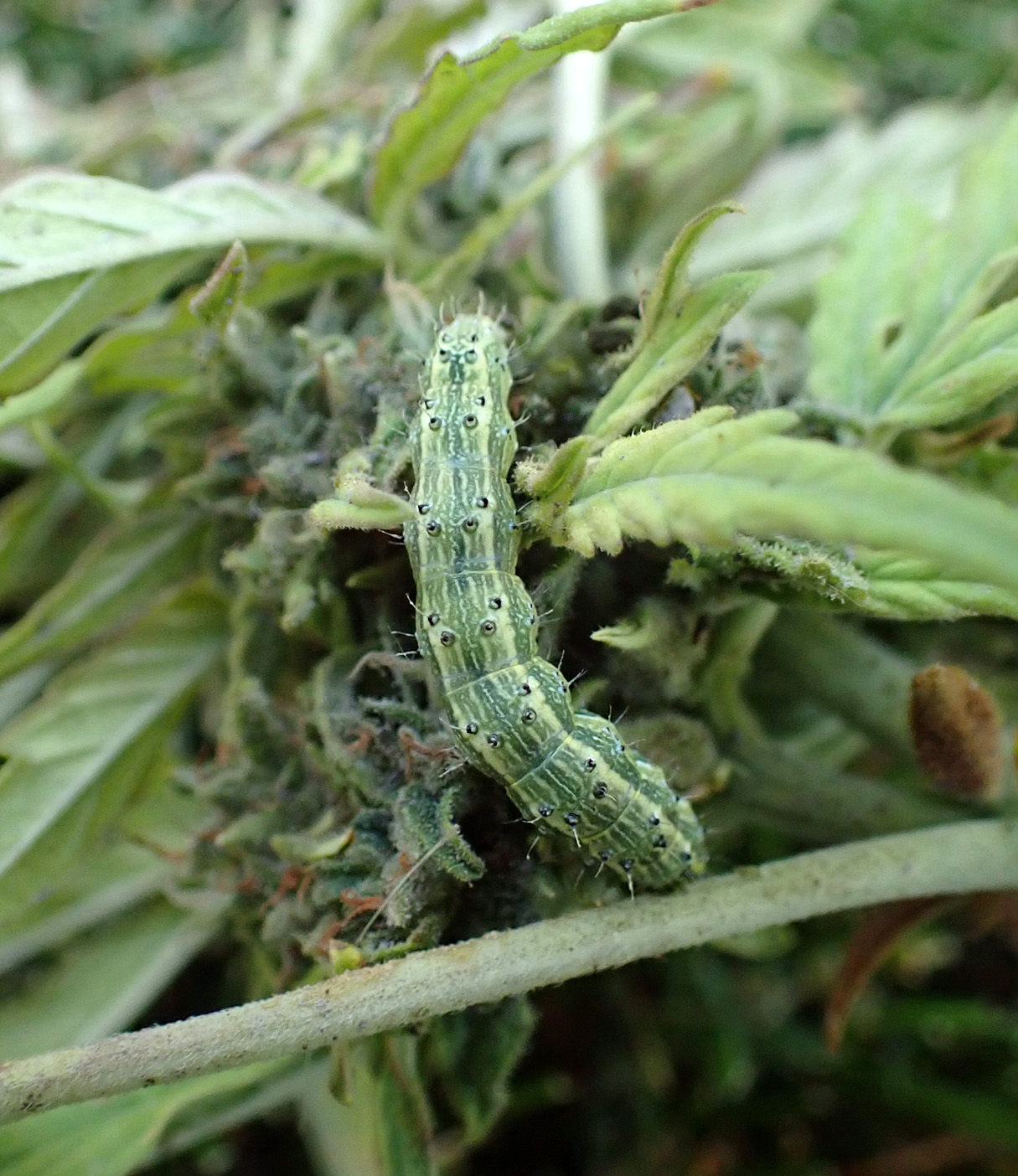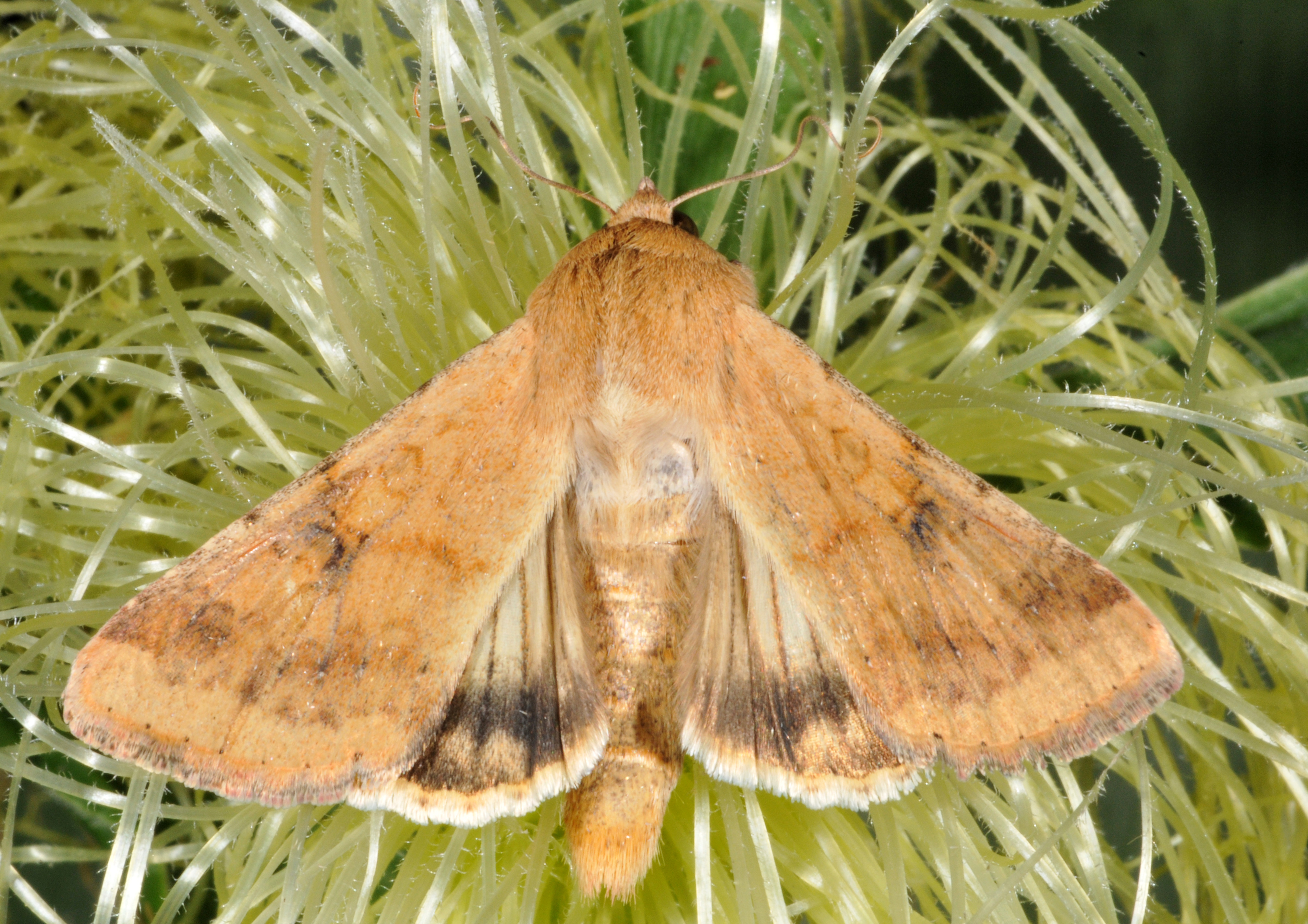Corn Earworm
Helicoverpa zea
Hosts
- Field-grown hemp
- Artichoke
- Asparagus
- Corn
- Solonaceae crops (tomato, pepper, potatoes,etc.)
- Curcurbits
- Peas
- Beans
- Various weeds
Description
Caterpillars are brownheaded, with green, brown, or black bodies that have alternating dark and light stripes running lengthwise. Adult moths are tan-brown and the front wings are marked with a distinct dark spot in the center and darker bands near the outer margins.
Life Cycle
Egg | Larva | Pupa | Adult
- 2-4 generations per year in Utah may be possible depending on latitude and elevation.
- Pupae overwinter in soil in central and southern Utah, but they do not survive in northern Utah.
- Adults emerge in spring and migrate to northern locations.
- Adults mate and lay eggs singly on multiple host plants.
- Larvae feed on leaves and flower buds.
- When mature, larvae fall from the plant and pupate in the soil.
Damaing Lifestage(s): Larva
Damage Symptoms
Larvae tunnel into and destroy developing buds and seeds, which can negatively affect CBD production. Hemp grown for fiber will be less affected.
Time for Concern
During flower bud formation and through harvest.
When and Where to Scout
- Monitor adult moths with a Heliothis trap and corn earworm pheromone lure starting in July, and check traps every three to five days.
- Each week, inspect plants during flowering stage for larvae or brown frass (excrement) on flower buds.
Threat Level
High for field-grown CBD.
Occurrence in Utah
Damage has been found on flower buds in scattered locations in Utah, but it is not as widespread as in neighboring states.
Management
- There is no trap threshold for treatment in hemp, so periods of abundant trap catch based on your own historic records will be the critical time for crop protection.
- Approved insecticides are available. One option is Bacillus thuringiensis (Bt), which should only be used when caterpillars are less than one-half inch in size. Target developing buds with insecticides.
- Crops will have to be protected throughout the adult flight periods, so continued monitoring and reapplications must occur.
When to Consider Treatment
During flowering stage, if large numbers are trapped or larvae are found.
Look-alikes
Other caterpillars in the Noctuidae family (cutworms; armyworms)
Caterpillar Insecticides
| Utah-Registered Product | Active Ingredient(s) | Notes |
|---|---|---|
| Agree WG | Bacillus thuringiensis ssp. aizawa | |
| Aza-Direct Biological Insecticide | azadirachtin | |
| AzaGuard | azadirachtin | |
| AzaSol | azadirachtin | |
| Azatin O Biological Insecticide | azadirachtin | |
| Azatrol EC Insecticide | azadirachtin | |
| Azera Insecticide | azadirachtin | |
| BT Now | Bacillus thuringiensis ssp. kurstaki | Greenhouse use only. |
| Bug Buster-O Extinguish Ant Bait | pyrethrins | Greenhouse use only. |
| Deadzone | diatomaceous earth | |
| Deliver Biological Insecticide | Bacillus thuringiensis ssp. kurstaki | |
| DiPel DF Biological Insecticide | Bacillus thuringiensis ssp. kurstaki | |
| DiPel DF Biological Insecticide Dry Flowable |
Bacillus thuringiensis ssp. kurstaki | |
| DiPel PRO DF Biological Insecticide | Bacillus thuringiensis ssp. kurstaki | |
| Evergreen Crop Protection EC 60-6 | pyrethrins | |
| Ferti-Lome Dipel Dust Biological Insecticide (RTU) | Bacillus thuringiensis ssp. kurstaki | |
| Ferti-lome Fruit Tree Spray | pyrethrins | |
| Gemstar LC | Polyhedral occulsion bodies (Obs) of nuclear polyhedrosis virus of Helicoverpa zea (corn earworm) |
|
| Grandevo CG;WDG | Chromobacterium sub strain PRAA4-1 cells | |
| Javelin WG Biological Insecticide | Bacillus thuringiensis ssp. kurstaki | |
| Leprotec | Bacillus thuringiensis ssp. kurstaki | |
| Molt-X | azadirachtin | |
| Neemix 4.5 Insect Growth Regulator | azadirachtin | |
| Prizefighter | ammonium nonanoate | |
| Pycana | pyrethrins | Greenhouse use only. |
| Pyganic Crop Protection EC 1.4 II; 5.0 II | pyrethrins | |
| SPEAR-LEP | gs-omega/kappahxtx-hv1a | Supression only; combine with a Bt product for greater efficacy. |
| Tersus Insecticide | pyrethrins | |
| Thuricide N/G | Bacillus thuringiensis ssp. kurstaki | |
| Valent Professional Products DiPel Pro DF Biological Insecticide Dry Flowable |
Bacillus thuringiensis ssp. kurstaki | |
| Venerate CG | Burkholderia sp. strain A396 | |
| XenTari Biological Insecticide Dry Flowable | Bacillus thuringiensis ssp. aizawai |
Photo Credits
Damage/Brown larva - Whitney Cranshaw, Colorado State University, Bugwood.org
Adult - Purdue University Extension Entomology
Trap/green larva - USU Extension IPM Program






